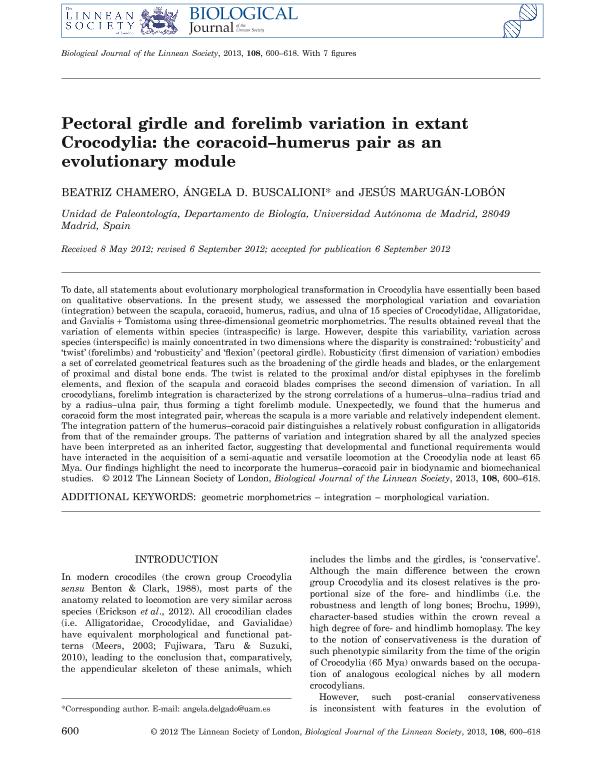Mostrar el registro sencillo del ítem
dc.contributor.author
Chamero Macho, Beatriz

dc.contributor.author
Marugán Lobón, Jesús
dc.contributor.author
Buscalioni, Ángela D.
dc.date.available
2017-06-30T20:21:53Z
dc.date.issued
2013
dc.identifier.citation
Chamero Macho, Beatriz; Marugán Lobón, Jesús; Buscalioni, Ángela D.; Pectoral girdle and forelimb variation in extant Crocodylia: the coracoid–humerus pair as an evolutionary module; Wiley Blackwell Publishing, Inc; Biological Journal Of The Linnean Society; 108; 3; -1-2013; 600-618
dc.identifier.issn
0024-4066
dc.identifier.uri
http://hdl.handle.net/11336/19329
dc.description.abstract
To date, all statements about evolutionary morphological transformation in Crocodylia have essentially been based on qualitative observations. In the present study, we assessed the morphological variation and covariation (integration) between the scapula, coracoid, humerus, radius, and ulna of 15 species of Crocodylidae, Alligatoridae, and Gavialis + Tomistoma using three-dimensional geometric morphometrics. The results obtained reveal that the variation of elements within species (intraspecific) is large. However, despite this variability, variation across species (interspecific) is mainly concentrated in two dimensions where the disparity is constrained: ‘robusticity’ and ‘twist’ (forelimbs) and ‘robusticity’ and ‘flexion’ (pectoral girdle). Robusticity (first dimension of variation) embodies a set of correlated geometrical features such as the broadening of the girdle heads and blades, or the enlargement of proximal and distal bone ends. The twist is related to the proximal and/or distal epiphyses in the forelimb elements, and flexion of the scapula and coracoid blades comprises the second dimension of variation. In all crocodylians, forelimb integration is characterized by the strong correlations of a humerus–ulna–radius triad and by a radius–ulna pair, thus forming a tight forelimb module. Unexpectedly, we found that the humerus and coracoid form the most integrated pair, whereas the scapula is a more variable and relatively independent element. The integration pattern of the humerus–coracoid pair distinguishes a relatively robust configuration in alligatorids from that of the remainder groups. The patterns of variation and integration shared by all the analyzed species have been interpreted as an inherited factor, suggesting that developmental and functional requirements would have interacted in the acquisition of a semi-aquatic and versatile locomotion at the Crocodylia node at least 65 Mya. Our findings highlight the need to incorporate the humerus–coracoid pair in biodynamic and biomechanical studies.
dc.format
application/pdf
dc.language.iso
eng
dc.publisher
Wiley Blackwell Publishing, Inc

dc.rights
info:eu-repo/semantics/openAccess
dc.rights.uri
https://creativecommons.org/licenses/by-nc-sa/2.5/ar/
dc.subject
Crocodylia
dc.subject
Evolutionary Module
dc.subject
Forelimb
dc.subject
Morphological Variation And Integration
dc.subject
Pectoral Girdle
dc.subject
3d Geometric Morphometrics
dc.subject
Geometric Morphometrics
dc.subject
Integration
dc.subject
Morphological Variation
dc.subject.classification
Paleontología

dc.subject.classification
Ciencias de la Tierra y relacionadas con el Medio Ambiente

dc.subject.classification
CIENCIAS NATURALES Y EXACTAS

dc.title
Pectoral girdle and forelimb variation in extant Crocodylia: the coracoid–humerus pair as an evolutionary module
dc.type
info:eu-repo/semantics/article
dc.type
info:ar-repo/semantics/artículo
dc.type
info:eu-repo/semantics/publishedVersion
dc.date.updated
2016-04-19T15:32:06Z
dc.journal.volume
108
dc.journal.number
3
dc.journal.pagination
600-618
dc.journal.pais
Reino Unido

dc.journal.ciudad
Londres
dc.description.fil
Fil: Chamero Macho, Beatriz. Universidad Autónoma de Madrid. Facultad de Ciencias; España. Museo Paleontológico Egidio Feruglio; Argentina. Consejo Nacional de Investigaciones Científicas y Técnicas; Argentina
dc.description.fil
Fil: Marugán Lobón, Jesús. Universidad Autónoma de Madrid. Facultad de Ciencias; España
dc.description.fil
Fil: Buscalioni, Ángela D.. Universidad Autónoma de Madrid. Facultad de Ciencias; España
dc.journal.title
Biological Journal Of The Linnean Society

dc.relation.alternativeid
info:eu-repo/semantics/altIdentifier/url/https://academic.oup.com/biolinnean/article-lookup/doi/10.1111/j.1095-8312.2012.02037.x
dc.relation.alternativeid
info:eu-repo/semantics/altIdentifier/doi/http://dx.doi.org/10.1111/j.1095-8312.2012.02037.x
Archivos asociados
